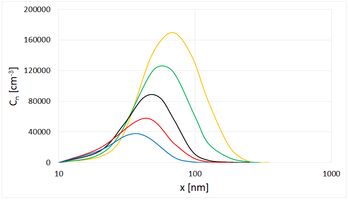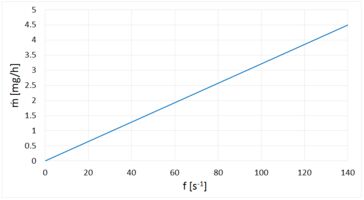DNP digital 3000

Particle measurement devices should be calibrated using particles with characteristics, e.g., shape, size, density, surface condition, and refractive index, similar to those of the actual aerosol to be tested, e.g., diesel soot.
The new DNP digital 3000 generates a condensation aerosol from monolithic graphite. The resulting carbon agglomerates are similar to diesel soot concerning particle size distribution.
Due to the new digital regulation, the generator enables an enhanced setting range and an even higher constancy of the generated particle size and concentration.
The particle measurement program (PMP) recommends that the particle size be adjusted to 30 nm, 50 nm, and 100 nm for calibration of the complete measurement chain. The 30 nm, 50 nm, and 100 nm particle fractions can be classified with a DEMC (differential electro-mobility classifier) based on the particle spectrum provided by the DNP digital 3000. The DNP digital 3000 can quickly, reliably, and reproducibly determine a particle measurement chain's transmission behavior/function, e.g., the PMP measurement chain and individual components at corresponding temperatures of up to 400 °C.
The DNP digital 3000 has mass flow controllers to control the volume flows for nitrogen and dilution air. The DNP digital 3000 is controlled using a built-in touch display.
The built-in touch display can adjust the DNP digital 3000 device parameters individually. For more effortless operation, saving parameter sets and retrieving them when restarting the device is possible. In addition, the REF 3000 reference exhaust can be controlled separately using the DNP digital 3000.
The DNP digital 3000 requires nitrogen or argon as the carrier gas. Nitrogen or argon causes virtually no change in the density of the exhaust gas being measured.
The carrier gas argon is mainly used in academic applications, e.g., to evaluate the effect of nanoparticles in inhalation or toxicology. In that field, Prof. Oberdörster from the University of Rochester Medical Center did a lot of academic research with the previous device, GFG 1000, and published many academic papers with different electroconductive electrodes.
Operation principle
Generation of nano-scale test aerosols through condensation
The DNP digital 3000 aerosol generator generates a jump spark between two graphite electrodes under high voltage. The jump spark rips tiny amounts of graphite from the electrodes at high temperatures. The graphite vaporized by this spark then condenses to form highly tiny particles. The high number concentration can result in the coagulation of these very small particles into agglomerates. The aerosol can be diluted by adding mixed air, enabling the defined adjustment of the agglomerate formation. The generated aerosol distribution is very similar to the distribution of diesel soot particles from a combustion engine. The energy converted in each spark remains constant due to the continual spark over voltage. This continuous energy in each spark guarantees stable particle size distribution (see Fig. 1). A technically sophisticated control of the distance between the electrodes during burn-off ensures very high long-term stability. The mass flow can be quickly and easily adjusted within a wide range using the spark frequency (see Fig. 2).
The digital regulation of the frequency and the continuous regulation of the voltage guarantee a more specific regulation of the distance between the two electrodes. This enables a higher constancy of the particle size distribution and the mass flow. Furthermore, every single spark can be regulated, and the energy of the single spark can be determined in principle. An AK protocol for an Ethernet connection via UDP protocol is part of the delivery.
Due to its easy startup, excellent reproducibility, and high functional reliability, the DNP digital 3000 is exceptionally well suited for calibrating particle measurement devices. Because of the superb reproducibility and easy handling, the DNP digital 3000, combined with the REF 3000 reference exhaust, successfully calibrates the PMP measurement chain in the particle measurement program.
Carrier gas: Nitrogen or Argon
Fig. 1: Size distributions of the particle agglomerates at various spark frequencies
Fig. 2: Particle mass flow of the DNP digital 2000 as a function of the spark frequency
Benefits
Your special advantages
- Fast adjustable particle size distribution
- Very precise adjustment of volume flow via MassFlowController
- Excellent short-term and long-term particle size and concentration constancy
- Particle structure similar to that of diesel soot at graphite electrodes
- Apart from graphite electrodes, copper, silver or other electroconductive electrodes can be used as well
- For PMP-measuring section easy connectable to CVS systems in combination with RAS 3000 (accessories)
- No volatile parts in the aerosol
- Aerosol is temperature-resistant to 400 °C
- AK interface protocol for Ethernet via UDP protocol
- Easy to operate by touch display
- Highest reproducibility by saving the operation settings
- Easy transport
- Reliable function
- Best reproducibility
- Low maintenance
- Reduces your operating expenses
Applications
Individual solutions for various industries
- Calibration of PMP measurement chain
- Calibration of particle measurement devices
- Calibration of sampling lines
- Production of nano particles
- Inhalation exploration
- Toxicology
Technical features
In detail
- Particle size range
- 0.02 – 0.35 µm
- Volume flow
- 4 – 70 Nl/min
- Volume flow (accessories)
- 0 – 450 l/min (REF 3000)
- Volume flow (carrier/dispersion gas)
- 4 – 20 l/min
- Volume flow (dilution gas)
- 0 – 50 l/min
- Mass flow (particles)
- 0.1 – 25 mg/h (for carbon)
- Particle material
- Carbon, copper, silver, gold and other metals
- Dosing time
- Several hours nonstop
- Pre-pressure
- 4 – 8 bar
- Carrier/dispersion gas
- Nitrogen, argon
- Compressed air connection
- Quick coupling
- Aerosol outlet connection
- Øinside = 6 mm, Øoutside = 8 mm
- Particle size range (primary particles)
- 3 – 10 nm
- Dilution gas
- Particle-free and dry compressed air
- Dimensions
- 185 • 445 • 380 mm (H • W • D)
- Weight
- 23 kg

